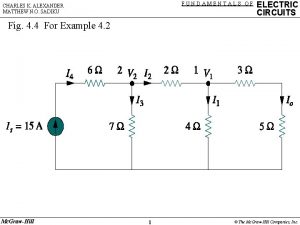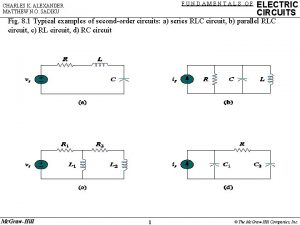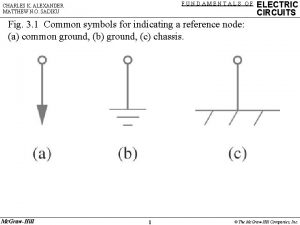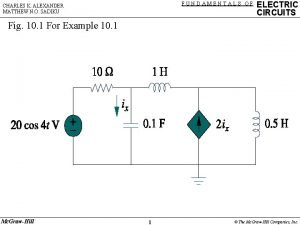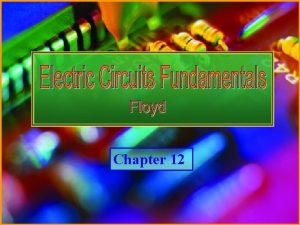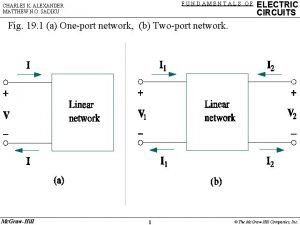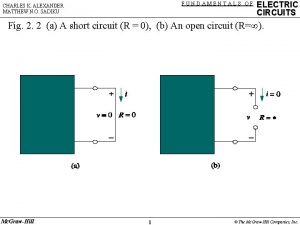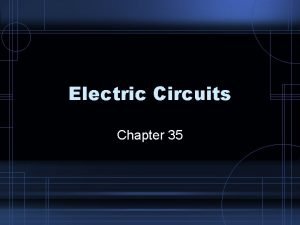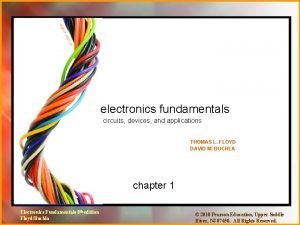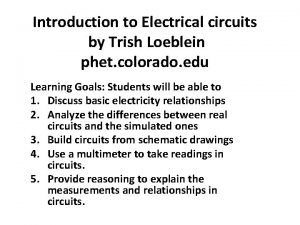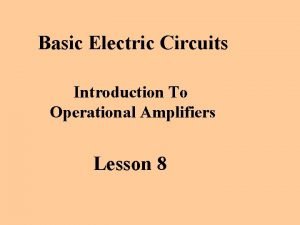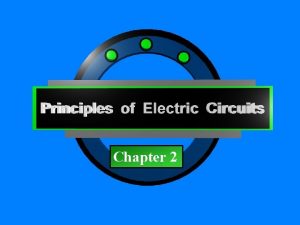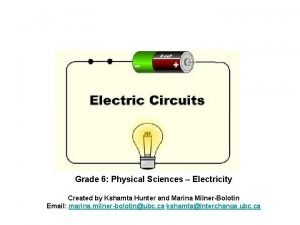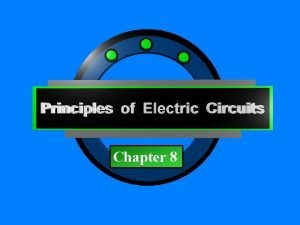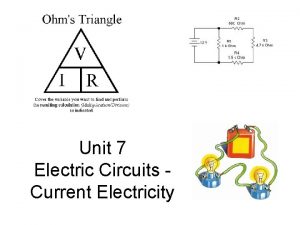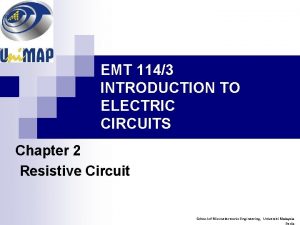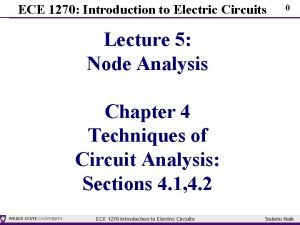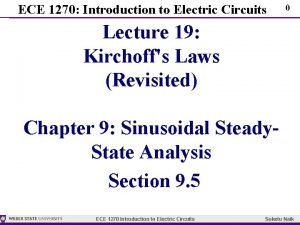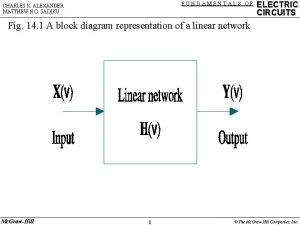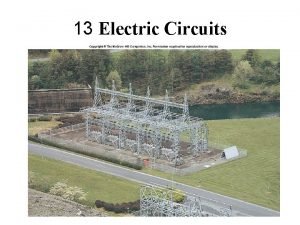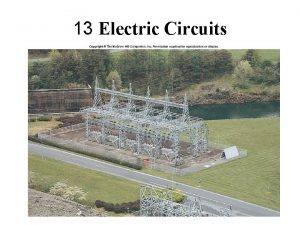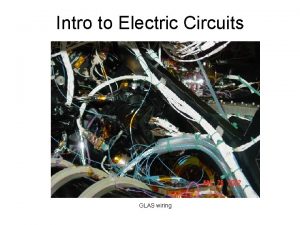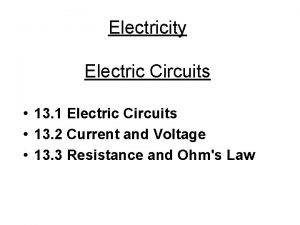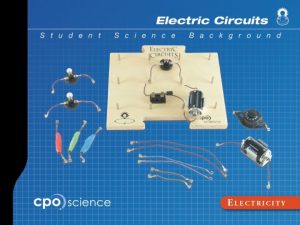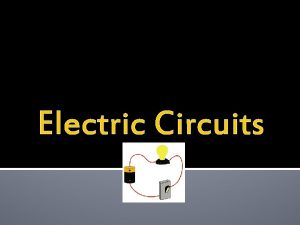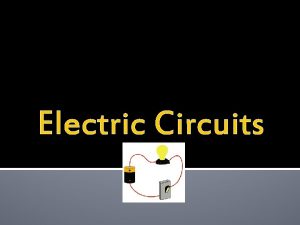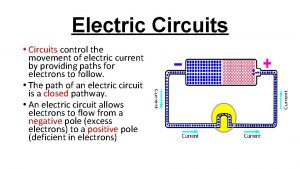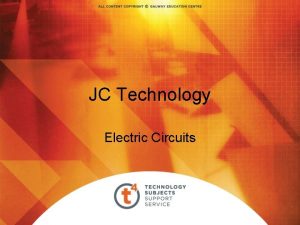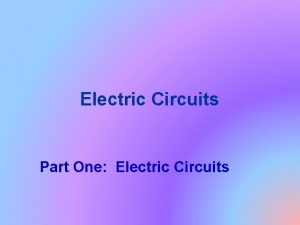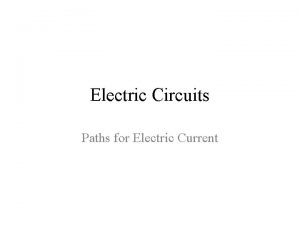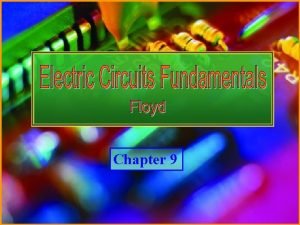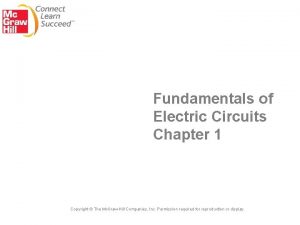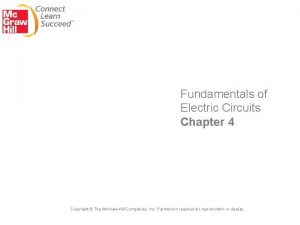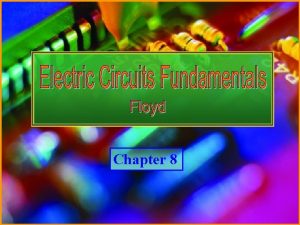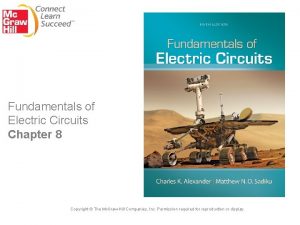Fundamentals of Electric Circuits Chapter 9 Copyright The






































- Slides: 38

Fundamentals of Electric Circuits Chapter 9 Copyright © The Mc. Graw-Hill Companies, Inc. Permission required for reproduction or display.

Overview • This chapter will cover alternating current. • A discussion of complex numbers is included prior to introducing phasors. • Applications of phasors and frequency domain analysis for circuits including resistors, capacitors, and inductors will be covered. • The concept of impedance and admittance is also introduced. 2

Alternating Current • Alternating Current, or AC, is the dominant form of electrical power that is delivered to homes and industry. • In the late 1800’s there was a battle between proponents of DC and AC. • AC won out due to its efficiency for long distance transmission. • AC is a sinusoidal current, meaning the current reverses at regular times and has alternating positive and negative values. 3

Sinusoids • Sinusoids are interesting to us because there a number of natural phenomenon that are sinusoidal in nature. • It is also a very easy signal to generate and transmit. • Also, through Fourier analysis, any practical periodic function can be made by adding sinusoids. • Lastly, they are very easy to handle mathematically. 4

Sinusoids • A sinusoidal forcing function produces both a transient and a steady state response. • When the transient has died out, we say the circuit is in sinusoidal steady state. • A sinusoidal voltage may be represented as: • From the waveform shown below, one characteristic is clear: The function repeats itself every T seconds. • This is called the period 5

Sinusoids • The period is inversely related to another important characteristic, the frequency • The units of this is cycles per second, or Hertz (Hz) • It is often useful to refer to frequency in angular terms: • Here the angular frequency is in radians per second 6

• A general expression for the sinusoid, where Vm = the amplitude of the sinusoid ω = the angular frequency in radians/s Ф = the phase 7

Sinusoids • More generally, we need to account for relative timing of one wave versus another. • This can be done by including a phase shift, : • Consider the two sinusoids: 8

Example 1 Given a sinusoid, , calculate its amplitude, phase, angular frequency, period, and frequency. Solution: Amplitude = 5, phase = – 60 o, angular frequency = 4 p rad/s, Period = 0. 5 s, frequency = 2 Hz. 9

Sinusoids • If two sinusoids are in phase, then this means that the reach their maximum and minimum at the same time. • Sinusoids may be expressed as sine or cosine. • The conversion between them is: 10

Complex Numbers • A powerful method for representing sinusoids is the phasor. • But in order to understand how they work, we need to cover some complex numbers first. • A complex number z can be represented in rectangular form as: • It can also be written in polar or exponential form as: 11

Complex Numbers • The different forms can be interconverted. • Starting with rectangular form, one can go to polar: • Likewise, from polar to rectangular form goes as follows: 12

Complex Numbers • The following mathematical operations are important Addition Subtraction Multiplication Division Reciprocal Square Root Complex Conjugate 13

Phasors • The idea of a phasor representation is based on Euler’s identity: • From this we can represent a sinusoid as the real component of a vector in the complex plane. • The length of the vector is the amplitude of the sinusoid. • The vector, V, in polar form, is at an angle with respect to the positive real axis. 14

• A phasor is a complex number that represents the amplitude and phase of a sinusoid. • It can be represented in one of the following three forms: a. Rectangul ar b. Polar c. Exponenti al where 15

Example 3 • Evaluate the following complex numbers: a. b. Solution: a. – 15. 5 + j 13. 67 b. 8. 293 + j 2. 2 16

Phasors • Phasors are typically represented at t=0. • As such, the transformation between time domain to phasor domain is: • They can be graphically represented as shown here. 17

Transform the following sinusoids to phasors: i = 6 cos(50 t – 40 o) A v = – 4 sin(30 t + 50 o) V cos (wt +90 o )= - sin wt, cos (wt -90 o )= sin wt Solution: a. I A b. Since –sin(A) = cos(A+90 o); v(t) = 4 cos (30 t+50 o+90 o) = 4 cos(30 t+140 o) V Transform to phasor => V V 18

Sinusoid-Phasor Transformation • Here is a handy table for transforming various time domain sinusoids into phasor domain: 19

Sinusoid-Phasor Transformation • Note that the frequency of the phasor is not explicitly shown in the phasor diagram • For this reason phasor domain is also known as frequency domain. • Applying a derivative to a phasor yields: • Applying an integral to a phasor yeilds: 20

Phasor Relationships for Resistors • Each circuit element has a relationship between its current and voltage. • These can be mapped into phasor relationships very simply for resistors capacitors and inductor. • For the resistor, the voltage and current are related via Ohm’s law. • As such, the voltage and current are in phase with each other. 21

Phasor Relationships for Inductors • Inductors on the other hand have a phase shift between the voltage and current. • In this case, the voltage leads the current by 90°. • Or one says the current lags the voltage, which is the standard convention. • This is represented on the phasor diagram by a positive phase angle between the voltage and current. 22

Phasor Relationships for Capacitors • Capacitors have the opposite phase relationship as compared to inductors. • In their case, the current leads the voltage. • In a phasor diagram, this corresponds to a negative phase angle between the voltage and current. 23

Voltage current relationships 24

25

Impedance and Admittance • It is possible to expand Ohm’s law to capacitors and inductors. • In time domain, this would be tricky as the ratios of voltage and current and always changing. • But in frequency domain it is straightforward • The impedance of a circuit element is the ratio of the phasor voltage to the phasor current. • Admittance is simply the inverse of impedance. 26

Impedance and Admittance • It is important to realize that in frequency domain, the values obtained for impedance are only valid at that frequency. • Changing to a new frequency will require recalculating the values. • The impedance of capacitors and inductors are shown here: 27

Impedance and Admittance • As a complex quantity, the impedance may be expressed in rectangular form. • The separation of the real and imaginary components is useful. • The real part is the resistance. • The imaginary component is called the reactance, X. • When it is positive, we say the impedance is inductive, and capacitive when it is negative. 28

Impedance and Admittance • Admittance, being the reciprocal of the impedance, is also a complex number. • It is measured in units of Siemens • The real part of the admittance is called the conductance, G • The imaginary part is called the susceptance, B • These are all expressed in Siemens or (mhos) • The impedance and admittance components can be related to each other: 29

Impedance and Admittance 30

31

Kirchoff’s Laws in Frequency Domain • A powerful aspect of phasors is that Kirchoff’s laws apply to them as well. • This means that a circuit transformed to frequency domain can be evaluated by the same methodology developed for KVL and KCL. • One consequence is that there will likely be complex values. 32

Impedance Combinations • Once in frequency domain, the impedance elements are generalized. • Combinations will follow the rules for resistors: 33

Impedance Combinations • Series combinations will result in a sum of the impedance elements: • Here then two elements in series can act like a voltage divider 34

Parallel Combination • Likewise, elements combined in parallel will combine in the same fashion as resistors in parallel: 35

36

Admittance • Expressed as admittance, though, they are again a sum: • Once again, these elements can act as a current divider: 37

Impedance Combinations • The Delta-Wye transformation is: 38
 Fundamentals of electric circuits chapter 4 solutions
Fundamentals of electric circuits chapter 4 solutions Fundamentals of electric circuits chapter 9 solutions
Fundamentals of electric circuits chapter 9 solutions Fundamentals of electric circuits chapter 7 solutions
Fundamentals of electric circuits chapter 7 solutions Sadiku
Sadiku Sadiku
Sadiku Sadiku
Sadiku Fundamentals of electric circuits
Fundamentals of electric circuits Electric circuits fundamentals floyd
Electric circuits fundamentals floyd Alexander
Alexander Sadiku
Sadiku Ise fundamentals of electric circuits
Ise fundamentals of electric circuits Chapter 20 electric circuits
Chapter 20 electric circuits Conceptual physics chapter 35
Conceptual physics chapter 35 Chapter 20 electric circuits
Chapter 20 electric circuits Chapter 35 electric circuits answers
Chapter 35 electric circuits answers Ohm's law calculations worksheet
Ohm's law calculations worksheet Chapter 35 electric circuits
Chapter 35 electric circuits Advantages of parallel circuit over series circuit
Advantages of parallel circuit over series circuit Electronics fundamentals circuits devices and applications
Electronics fundamentals circuits devices and applications Chapter 21 electric charge and electric field
Chapter 21 electric charge and electric field Chapter 21 electric charge and electric field
Chapter 21 electric charge and electric field Chapter 16 electric charge and electric field
Chapter 16 electric charge and electric field Units of a charge
Units of a charge Phet electric circuit
Phet electric circuit Electric circuits equations
Electric circuits equations Electric circuits nilsson
Electric circuits nilsson Principles of electric circuits
Principles of electric circuits What three elements are required for all electric circuits
What three elements are required for all electric circuits Superposition electric circuits
Superposition electric circuits Electric circuits grade 6
Electric circuits grade 6 Principles of electric circuits 10th edition answer key
Principles of electric circuits 10th edition answer key Physics reference table
Physics reference table Introduction to electric circuits
Introduction to electric circuits Introduction to electric circuits
Introduction to electric circuits Introduction to electric circuits
Introduction to electric circuits Basic electrical engineering kulshreshtha
Basic electrical engineering kulshreshtha Fundamentals of electric
Fundamentals of electric Electric field and voltage
Electric field and voltage Electric potential due to a dipole
Electric potential due to a dipole



